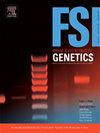Sequence-based population structure, relatedness, and inbreeding estimates for forensic autosomal STR markers
IF 3.2
2区 医学
Q2 GENETICS & HEREDITY
引用次数: 0
Abstract
Population data have become available for sequence data to aid forensic investigations and prepare the forensic community in the move towards implementing NGS methods. This comes with a need for updated population genetic parameters estimates to allow DNA evidence evaluations using sequence data. Initial work has been done on a small sample and here we expand this work by providing estimates of population structure and relatedness for autosomal STR data generated by sequencing technologies. We also discuss the effect of inbreeding on forensic calculations and discuss why the use of genotypic-based estimates may be preferred over allelic-based estimates.
基于序列的法医常染色体 STR 标记的种群结构、亲缘关系和近亲繁殖估计值
人口数据已可用于序列数据,以帮助法医调查,并为法医界采用 NGS 方法做好准备。这就需要更新种群遗传参数估计,以便利用序列数据进行 DNA 证据评估。最初的工作是在一个小样本上完成的,在此我们将扩展这项工作,为测序技术产生的常染色体 STR 数据提供种群结构和亲缘关系估计值。我们还讨论了近亲繁殖对法医计算的影响,并讨论了为什么使用基于基因型的估计值比基于等位基因的估计值更可取。
本文章由计算机程序翻译,如有差异,请以英文原文为准。
求助全文
约1分钟内获得全文
求助全文
来源期刊
CiteScore
7.50
自引率
32.30%
发文量
132
审稿时长
11.3 weeks
期刊介绍:
Forensic Science International: Genetics is the premier journal in the field of Forensic Genetics. This branch of Forensic Science can be defined as the application of genetics to human and non-human material (in the sense of a science with the purpose of studying inherited characteristics for the analysis of inter- and intra-specific variations in populations) for the resolution of legal conflicts.
The scope of the journal includes:
Forensic applications of human polymorphism.
Testing of paternity and other family relationships, immigration cases, typing of biological stains and tissues from criminal casework, identification of human remains by DNA testing methodologies.
Description of human polymorphisms of forensic interest, with special interest in DNA polymorphisms.
Autosomal DNA polymorphisms, mini- and microsatellites (or short tandem repeats, STRs), single nucleotide polymorphisms (SNPs), X and Y chromosome polymorphisms, mtDNA polymorphisms, and any other type of DNA variation with potential forensic applications.
Non-human DNA polymorphisms for crime scene investigation.
Population genetics of human polymorphisms of forensic interest.
Population data, especially from DNA polymorphisms of interest for the solution of forensic problems.
DNA typing methodologies and strategies.
Biostatistical methods in forensic genetics.
Evaluation of DNA evidence in forensic problems (such as paternity or immigration cases, criminal casework, identification), classical and new statistical approaches.
Standards in forensic genetics.
Recommendations of regulatory bodies concerning methods, markers, interpretation or strategies or proposals for procedural or technical standards.
Quality control.
Quality control and quality assurance strategies, proficiency testing for DNA typing methodologies.
Criminal DNA databases.
Technical, legal and statistical issues.
General ethical and legal issues related to forensic genetics.

 求助内容:
求助内容: 应助结果提醒方式:
应助结果提醒方式:


